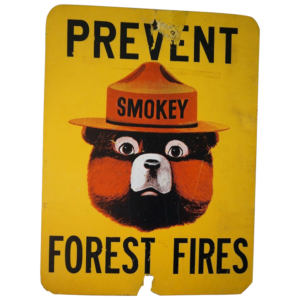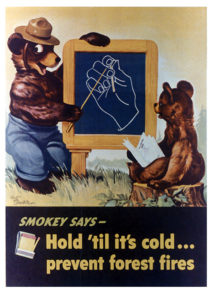
“Only you can prevent forest fires!” We must have heard those words a thousand times, as we sat in the floor after school watching Leave It to Beaver on our black-and-white TV’s.
Forest fires were a non-issue for me. We had woods in Oklahoma’s Green Country, but I can’t ever recall a forest fire. Our summers typically were rainy, and the vegetation didn’t dry up and turn to tinder the way it did in the western US, where the dry season ruled half the year.
Smokey Bear taught the Boomer generation about how dangerous forest fires were for everyone, especially cute cartoon animals, who would frequently be imperiled by a careless motorist who would toss his cigarette butt out the window.
Smokey, the real-life bear, was saved from death as a cub in 1950. The story can be found in detail here. Here’s the part that you might remember:
Amongst the smoldering ashes was a tiny black bear cub, burnt and afraid, clinging to a tree. The cub was nicknamed “Hotfoot Teddy.” They searched for the cub’s mother, but could not find her. The cub needed veterinary aid for the burns on his paws and hindquarters, so he was flown to Santa Fe to receive professional treatment. While his wounds were healing, he stayed at the home of Ray Bell, the game warden who flew him to Santa Fe. Ray’s daughter Judy befriended the little bear and helped nurse him back to health.
Renamed Smokey, the bear got a home at Washington, D.C.’s National Zoo. He drew millions of visitors until his death in 1975.
But the Smokey that we remember from all of those posters, TV spots, and magazine ads was actually “born” in 1944.
Uncle Sam had been depicted as a forest ranger in ads from the 1930’s encouraging the public to prevent forest fires. After Pearl Harbor, a leering image of a Japanese soldier was printed on posters telling our parents that “careless matches aid the Axis.” In fact, in 1942, a Japanese submarine shelled an oilfield near Santa Barbara that caused fears of enemy-launched forest conflagrations to swell.
The Japanese even launched balloons loaded with incendiaries, intending prevailing winds to carry them to the Washington and Oregon forests. At least one American died when stumbling upon one of the wind-carried bombs.
The 1942 success of Disney’s Bambi caused the diminutive deer’s image to be used for a year in forest fire awareness advertisements, but after the time period expired, the National Forest Service launched their own spokesman, arguably more famous nowadays than the fawn who also did much to start the anti-hunting movement.

Smokey’s popularity exploded, and the 1950 discovery of the injured cub only added to the frenzy. Smokey had a musical radio show, he was in comic books, and also appeared in ads that sold commercial products instead of getting the word out about fire danger.
Thus, in 1952, the Smokey Bear Act was passed which gave control of the various incarnations of the bear to the USDA.
Smokey was marketed hard during our childhoods, and he inspired us all to put out campfires, even if dad wasn’t quite done with them! Plus, he continued to be the inspiration for cartoon shows, toys, and other commercial interests, but now under the watchfulness of the feds.
Our kids and grandkids know the bear as well as we do. And they are just as obsessive about putting out campfires.
Well done, Smokey. 🙂
You will not believe this. I was sitting in my therapists office back in probably 1996 or so and I met a lady who was waiting there also. There was a pic of smokey on the wall. The lady told me that Smokey the Bear was her husband. On the sign it said “Only you can prevent forest fires”. She pointed to it and said “he used to say that all the time”. I smiled, nodded my head and said something, I don’t know what and then I was called into the office. This lady seemed so nice. Well spoken. Pleasant. I have never forgotten her!